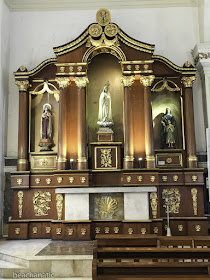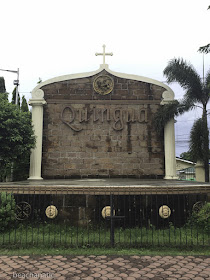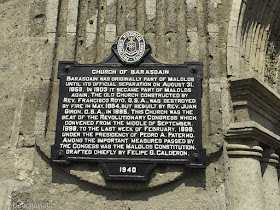This post consists of the parish churches of the Basilica Minore of the Immaculate Conception, Malolos; Our Lady of Mt. Carmel Parish Church, Barasoian; Nuestra Señora de la Asuncion, Bulacan; St. James the Apostle Parish Church, Paombong; National Shrine of St. Anne, Hagonoy; St. James the Apostle Parish Church, Plaridel and San Isidro Parish Church, Pulilan
1.
BASILICA MINORE OF THE IMMACULATE CONCEPTION, MALOLOS
CATHEDRAL,
Poblacion, Malolos City, Bulacan (F-1580)
The
town of Malolos was founded in 1850 by the Augustinians.
In
this convent, Gen. Emilio Aguinaldo as president of the first Philippine
republic held office from Sept. 10, 1898 to March 29, 1899.
The present church
was built in 1859. The façade is divided into three vertical segments by Doric
columns with three semicircular arched entrances. The belfry on the left side of the church has
the statue of the Blessed Virgin Mary on the top.
 |
| The statue of the Immaculate Conception is prominently displayed in the single niche retablo. |
 |
| Side altar. |
 |
| The dome. |
 |
| The painting on the ceiling by the altar. |
 |
| The statue of the Immaculate Conception on the main Altar. |
 |
| Side altar. |
 |
| The Cathedra of the bishop. |
 |
| Chapel of the saints. |
The Cathedra has also been refurbished.
2.
OUR LADY OF MT. CARMEL PARISH,
BARASOIAN,
Malolos City, Bulacan (F-1859)
Originally a part of Malolos,
Barasoian became a town in 1859. In 1903 it became a part of Malolos again. The
original church was destroyed by fire in 1884 but was rebuilt the following
year. This church complex housed the revolutionary congress which was
inaugurated on Sept. 15, 1898. Pedro A.
Paterno was President. It was here that the congress, among other measures,
discussed and approved the Malolos Constitution
in 1898. In August 1973, the National Historical Institute declared Barasoian
church and convent a national landmark.
The façade is distinguished by its
semicircular pediment with a rose window on top of the recessed main entrance
and two smaller side entrances. The belfry on the right side of the church
rises from a cube base into a polygonal three layered structure with blind and
open windows.
 |
| Intricate bas-relief carvings on the main door of the church. |
 |
| Main altar retablo with a couple waiting the start of their marriage ceremony. |
 |
| Side altar of St. Joseph. |
 |
| Side altar of the Sacred Heart of Jesus. |
 |
| Bas-relief carving on the side door of the church. |
 |
| Barasoian church with a bride preparing to process down the aisle. |
3.
NUESTRA SEÑORA DE LA ASUNCION,
BULAKAN, BULACAN
(F-1578)
The town of Bulakan was founded by the
Augustinians in 1578 under the protection of the Assumption of Our Lady.
Bulakan was the former capital of the province of Bulacan. The church
construction started in 1578. It was burned and desecrated by the British in
1762 during the invasion of Manila. Was built again in 1812, the bell tower
being built in 1872. Got destroyed again in the earthquakes of 1863, 1869 and
1880. Rebuilt according to a Neo-Byzantine design in 1884-1885. Bell tower
finished in 1889. Renovated again in 1955-1975.
The church is distinguished by its single
entrance with a rose window on top
within a recessed arch resting on three slender columns.
 |
| Altar retablo with bas-reliefs of saints on the side panels. |
 |
| The town hall of Bulakan, Bulacan. |
4.
ST. JAMES THE APOSTLE PARISH CHURCH,
PAOMBONG, BULACAN (F-1619)
The façade of the church is distinguished
by six rectangular columns, the middle columns of which joined by a canopy almost
reaches to the end of the triangular pediment. It has three recessed entrances
with semicircular arches on top of three columns.
 |
| The baptismal font. |
5.
NATIONAL SHRINE
OF ST. ANNE,
HAGONOY, BULACAN (F-1580)
The town of Hagonoy was founded by
the Augustinians on January 17, 1582 with St. Anne as its patron saint. The church of stone and bricks was built in
1731 but has undergone several restorations since then. The latest addition
would be the large portico in front of the main entrance, which is also flanked
by two other side entrances. The base of the triangular pediment has four columns
topped by four Augustinian saints. In the middle of the pediment and just above the rose
window is a bas-relief statue of St. Anne.
 |
| Interior of the church. |
 |
| The altar retablo of St. Anne. |
6.
ST. JAMES THE APOSTLE PARISH CHURCH,
PLARIDEL,
BULACAN (F-1602)
The town of Plaridel founded by the
Augustinians was formerly called Quingua. It was changed to Plaridel in the 20th
century in honor of its famous son, Marcelo del Pilar. The patron saint of the town is St. James the
Apostle.
The façade is characterized by a Moorish
pediment with decorative elements plastered on it. It has a rose window with a
stained glass depicting St. James the Apostle. There is only one main entrance
in a Moorish arch with niches on the sides. A canopy extends in front of the
main entrance.
 |
| Quingua, the old name of the town of Plaridel. |
 |
| The altar retablo. |
 |
| The garden by the side of the church. |
7.
SAN ISIDRO LABRADOR PARISH CHURCH,
PULILAN,
BULACAN (F-1749)
The façade of the church is simple
with four pillars topped by a triangular pediment. The only front entrance is covered by a small canopy with the statue of St. Isidore placed
on top. There are two niches beside the entrance with the statue of saints. The
belfry on the right has a circular roof.
The church was solemnly dedicated by
the Most Rev. Jose Oliveros, Bishop of Malolos on February 7, 2013 on the
occasion of the Golden Jubilee of the Diocese of Malolos.
 |
| The cemetery is just beside the church. |
 |
| The Holy water stoup. |
 |
| The altar fenced off by a metallic lattice work as a communion rail. |
 |
| Arched doorway to the convento. |





.jpg)
.jpg)
.jpg)
.jpg)
.jpg)
.jpg)
.jpg)
.jpg)






.jpg)
.jpg)
.jpg)































No comments:
Post a Comment